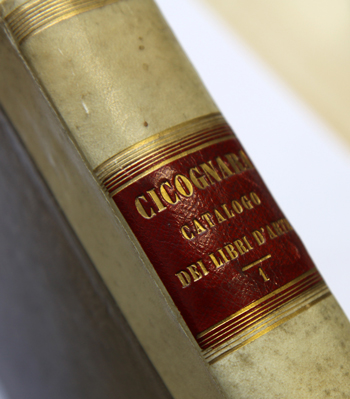The Digital Cicognara Library
About
Introducing the Digital Cicognara Library

The Digital Cicognara Library is an international initiative to recreate in digital form the remarkable private book collection of Count Leopoldo Cicognara (1767–1834). Though assembled in the Romantic era, Cicognara’s collection of some five thousand early imprints stands as an important scholarly resource for the literature of art and archaeology. Cicognara’s famous, two-volume inventory of his library, the Catalogo ragionato dei libri d’arte e d’antichità, published in 1821 and often reprinted, remains an essential tool for scholars and bibliophiles.
The full Digital Cicognara Library is being built by contributing partners. The site presents the full text of the Catalogo integrated with digital images and full text of every title in the corpus, including black-and-white facsimiles of the original volumes in the Vatican, one or more high-resolution, color facsimiles of unique copies from partner libraries, and thorough bibliographic information. Thanks to generous support from the Samuel H. Kress Foundation and partner institutions, the Digital Cicognara Library will be an open-access resource.
About the Cicognara Library

The Cicognara bibliographical corpus virtually defines the early literature of art. The collection includes treatises on art and architecture; artist and architect biographies; technical handbooks, manuals, and dictionaries of art, architecture, drawing, painting and sculpture; texts on the decorative arts; emblem books and iconographic handbooks; studies on costume, theatre and public spectacles; numismatic literature; works on aesthetics and the history and philosophy of art; topographical guides to collections and cultural sites; and early texts on the archaeology and antiquities of Greece and Rome. The texts are primarily in Italian, French, English, German, and Latin, and date from the fifteenth through the early nineteenth centuries.
In 1824, Cicognara sold his book collection to the Vatican Library where today it constitutes the Fondo Cicognara. For nearly two centuries, it has profoundly informed the work of art and architectural historians; scholars of ancient, Renaissance, and early modern history; students of the history of collecting, and the survival of antiquity; as well as bibliophiles and the rare book trade.
We know of no modern library that replicates the Fondo Cicognara in its entirety. In order to expand access to the early literature of art, the Samuel H. Kress Foundation sponsored a project in the 1980s to disseminate the full text of the Cicognara Library in microfiche. Led by art historian Philipp Fehl (1920–2000), with his wife Raina Fehl, the Leopoldo Cicognara Program at the University of Illinois at Urbana-Champaign (UIUC) worked in close partnership with the Vatican Library and the firm of Chadwyck-Healey to produce a microfiche edition of every title in the Catalogo totaling more than one million page images. The microfiche set has been sold or donated to dozens of libraries worldwide during the last thirty years, and metadata for each title is available in OCLC’s WorldCat.
Why Create a Digital Cicognara Library?
Today, digital technologies have become the preferred mode for preserving and accessing early printed works. In 2014, with encouragement from the Kress Foundation, an international group of libraries began to explore ways of making the entire corpus of the Fondo Cicognara freely available online. The result is the Digital Cicognara Library, a multi-year initiative launched in 2015.

©2017 Biblioteca Apostolica Vaticana
In addition to reproducing from the microform masters Cicognara’s own books in the Vatican, the Digital Cicognara Library will include a collection of variant copies of these early imprints—variants owned and digitized by partner libraries that correspond to the editions listed in the Catalogo. The copy-specific characteristics of the newly digitized volumes will provide new information about the early modern literature of art and its readership, Cicognara’s own reception and his wide-ranging impact on historical scholarship, and the development of research libraries.
The high-resolution scans created and hosted by holding institutions are available for viewing through a distributed network of image servers using the IIIF: International Image Interoperability Framework. The bibliographic descriptions and the full-text transcriptions will be fully searchable from a centralized database as well as via relevant subject research portals, including and especially the Getty Research Portal. Together, the aggregated images and text offer a potentially transformative opportunity for the discipline of art history. By using new technology to make these key historical volumes more widely accessible, the Digital Cicognara Library will allow scholars to ask and answer new questions.
